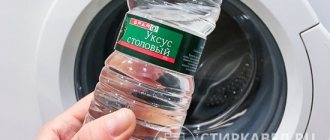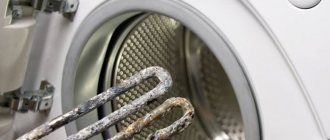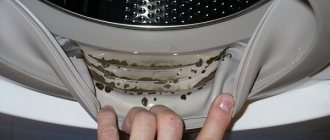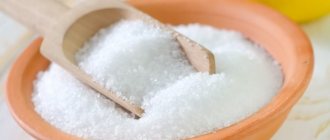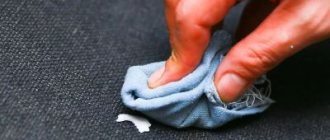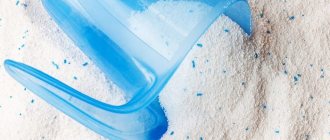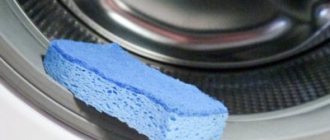Most modern housewives simply cannot imagine their lives without an automatic washing machine, which saves energy and time, greatly facilitating everyday household chores. However, not all of them know that a home assistant also needs regular care. And this should not be limited to wiping dust from the body, washing the detergent tray and adding anti-scale preparations. From time to time, much more extensive cleaning of the entire machine is required.
How to clean a washing machine
If this activity is not carried out periodically, the quality of washing clothes will decrease significantly over time, mold will appear on some parts of the appliance, and an unpleasant odor will begin to emanate from the drum. In order not to bring the situation to such a neglected state, it is necessary to regularly wash all the chambers of the machine.
Therefore, the question of how to clean a washing machine should be of interest to any owner. Moreover, in addition to the means offered by industry, there are more accessible, economical ways to restore proper order.
How to clean the drum
- Pour 100 ml of chlorine bleach into the machine drum and start the wash at a temperature of at least 60 °C. Without underwear, of course.
- You can use citric acid to remove scale. Pour 100 g into the drum and run the wash at maximum temperature. Ideally, the mode will include double rinsing. Then the plaque will be removed 100%.
- Mix a small amount of water and soda in a 1:1 ratio and pour the solution into the detergent compartment. Pour a little vinegar into the drum itself: no more than 400 ml. Set the temperature to maximum and let the machine do almost all the work for you. Then remove any remaining dirt with a sponge and wipe the drum dry. Plaque, mold and unpleasant odor will disappear without a trace.
Procedure for comprehensive cleaning
In addition to scale, there are other problems that can be caused by improper operation of the machine: dirt, unpleasant odor, mold. Therefore, you should regularly maintain the cleanliness of the internal elements.
Step #1 - wash the drum
After each wash, residual water and dirt remain in the drum. And soon black spots appear in the folds of the sealing cuff, and a musty smell comes from the depths of the machine.
Starting at idle speed with the addition of disinfectants or regular citric acid will help solve the odor issue. But the gum needs to be thoroughly cleaned by hand.
To clean the cuff, it is not recommended to use aggressive chemicals containing chlorine - such chemicals can make the rubber “hard” and quickly crack.
The easiest option is to carefully push the folds apart, wash the cuff around the circumference with a sponge, soap and warm water, and then wipe dry.
If you notice mold stains, you can use a solution of copper sulfate or prepare a cleaning paste of water and baking soda in equal proportions.
Then thoroughly treat the elastic band and the entire drum with this mixture, leave for a couple of hours, and then wipe with a sponge and start the long-term wash cycle.
For more information on cleaning your washing machine drum, see this article.
Step #2 - clean the filter and drain hose
The cause of an unpleasant odor can also be debris invisible to the eye - hair, particles of soil or building materials, lint, feathers and various small objects that were not removed from clothing pockets in time.
All this accumulates in the filter and hose through which the machine releases waste water. It is recommended to clean the washing machine drain filter at least once every 3 months, and more often during active use.
To do this, you need to remove the protective panel, place a small container for draining water or place a rag on the floor. Then unscrew counterclockwise and remove the filter. Rinse it under high pressure water and remove accumulated debris from the hole.
Typically the filter is located in one of the lower corners of the front of the panel and is covered with a small round or rectangular plate that can be easily pryed off with a flat-head screwdriver
To rinse the hose, you need to drain the remaining water in the machine through the drain filter and then disconnect it from the entrance to the sewer pipe or siphon. After this, you can remove the part, but exactly how to do this depends on the design of the device itself.
Ariston , Samsung , Indesit , Whirpool , Ardo machines you can only get to the hose connection through the bottom.
To do this, you need to lay the device on its side, remove the bottom panel and filter, and loosen the clamp with pliers. All that remains is to disconnect the pump and remove the hose itself.
Before disconnecting the hose, be sure to disconnect the device from the electrical network and turn off the water supply tap (if there is no separate one for the machine, then the apartment one)
In Electrolux and Zanussi you need to look for the drain fastening behind the rear panel, and in Bosch and Siemens - behind the front, when it comes to front-loading machines.
But for vertical models, you can only get to the hose through the side cover. Therefore, it will not be superfluous to check the instructions, which describe the device diagram.
To clean the drainage hose from dirt and powder deposits, equip yourself with a thin non-metallic cable with a mini brush attached to one end.
We run this brush inside, scroll it and gradually move it to the end of the hose. Then rinse under pressure of warm water. For severe contamination, several passes can be made.
Step #3 - wash the powder container
A rough coating from hard water appears on the walls of the detergent compartment, and traces of powder and various rinse aids remain. All this needs to be removed.
If the remnants of detergents are quite easily removed with warm water and a sponge, then limescale or mold will have to be fought
We act in stages:
- We remove the cuvette from the compartment and remove the container for the conditioner.
- We rinse under running water, wipe off mold stains with soda or any chlorine-containing product (there are no rubber elements here, so chlorine will not harm).
- Pour a packet of citric acid into a small bowl.
- Place the disassembled cuvette, fill it with hot water and leave for an hour (if it is heavily soiled, it can be overnight).
- Then we remove the remaining plaque with a sponge and thoroughly clean all joints with a toothbrush.
- Dry the container, assemble and place in place.
Another option for dealing with plaque is to fill the removed cuvette with soda and add table vinegar. As a result of the reaction, the soda will foam and soften the lime deposits so that they are easier to remove.
In addition to the container itself, the powder receptacle itself also requires cleaning, and there are many hard-to-reach places with various recesses and small parts
To get rid of dirt and plaque in the container compartment, you can use the same soda paste and toothbrush, and pre-treating the tray with a spray cleaner will help speed up the process.
How to descale heating elements
- Citric acid will again help get rid of scale on the electric heater. The amount of powder depends on the degree of soiling, but on average, a machine with a 5 kg load requires 250 g. Pour 200 g into the powder compartment, and 50 into the drum and run the wash at maximum temperature.
- More aggressive acetic acid can also deal with scale. Just add 50 ml of vinegar to the conditioner container and turn on the machine. Be careful: vinegar can damage the rubber elements.
Prevention of plaque formation
To prevent scale from forming on the internal parts of the machine, it is necessary to carry out preventive cleaning from time to time. To do this, you can use any store-bought or folk remedy. With frequent use of the machine, it is necessary to carry out preventive maintenance once every three months, and with rare washings (1-2 times a week), it will be enough to carry out 2 procedures per year. You can extend the life of the heating element if you add water softeners at each wash: although they do not affect the quality of the wash, they significantly facilitate the work of the machine.
How to Clean a Drain Hose
When you clean the drum with baking soda and vinegar, the drain hose is also cleaned. But if a serious blockage occurs, additional measures must be taken.
Unplug the washing machine and turn off the water supply. Disconnect the hose from the machine (water may spill out during the process, so do not forget to substitute a container).
Now you can start cleaning. For it they use a Kevlar cable with a non-metallic (!) brush at the end. First clean the hose on one side, then the other, and finally rinse it under running hot water.
Cleaning the heating element and drum
The electric heater, which is constantly in contact with running water, occupies not the last place in the device of the washing machine. Therefore, it is important to regularly remove salts accumulated on it. How to remove scale from heating elements and drums? Below are the main methods that have long been proven by housewives.
Citric acid, vinegar, soda and bleach will help you clean your washing machine at home. After all, scale is calcium and magnesium salts, which are destroyed in an acidic environment.
Option 1: using improvised means
Here are a few ways to clean your washing machine with products you can find around the house:
- Pour lemon into the powder compartment and run some high-temperature mode. To know how much acidic powder to add, pay attention to the drum capacity and the degree of contamination. As a rule, 30 grams of acid per kilogram of load is taken.
- Use table vinegar. Pour a glass of 9% vinegar solution into the powder container, select washing at 90°C with soaking. You can then remove the smell from the drum with an additional rinse.
- You can prepare a solution. Mix half a glass of soda with half a glass of water and pour into the product compartment. Pour a glass of 9% acetic acid into the drum.
- Using bleach, substances containing chlorine.
On the Internet you can find other life hacks on how to clean your washing machine from scale and dirt. For example, pour five liters of Coca-Cola into a drum and leave for several hours. However, such methods are questionable; it is better to use time-tested methods.
You should not combine cleaning the machine and washing clothes. After the procedure, check the drain hose and drum cuff, remove scale particles.
It is good if there is a softening filter in the drain. But if it is missing, add Calgon to the powder - a special product for preventing contamination.
Water softener Calgon 500g
Option 2: chemical means
Cleaning washing machine parts using special chemicals has an advantage over traditional methods. Manufacturers develop the composition of such products taking into account the design features of the equipment, as well as safety for human health.
Study the composition of the product before purchasing. There are universal chemicals for cleaning the entire machine, and there is one that is intended only for removing mold and plaque.
Here is a list of the best anti-scale products for washing machines:
- Sano Antikalk Scale Remover . Made in Israel. Removes lime deposits from heating elements, drums, and housings. Does not contain harmful components. Also suitable for dishwashers. Extends the life of home aids and prevents rust.
- Tiret - cleaner for washing machines (Russia). Removes scale, detergent residues and other contaminants.
- Topperr 3004 . A German product recommended by the manufacturer Bosch. Effectively removes scale and is suitable for dishwashers.
- Magic Power . Made in Germany. It comes in powder and gel form and fights dirt on an electric heater or drum.
- Doctor TEN and Antinakipin are Russian and Belarusian manufacturers, respectively. They only remove scale, but are used to clean any equipment.
Washing machine care products
Be sure to read the description of the chemical product before purchasing and using. Many advertised substances (for example, Calgon) promise to protect your washing machine from scale, but do not help get rid of existing scale. They only reduce the amount of salts in running water. The difference between such preparations is significant - they are added during washing to the machine before starting, with powder or into the drum.
Option 3: Manually
Inspecting the electric heater is the first thing to do if you decide to clean the elements of the washing machine yourself. A thick layer of limestone is sometimes easier to remove by hand.
There is no need to use sharp objects for cleaning. There is a risk of damage to the coating of the heating element or its breakage. Place the element in citric acid diluted in water or in a solution with a special liquid.
Steps to manually clean an electric heater:
- First you need to disconnect the wires and sensor and remove the heating element.
- Then rinse the device with hot water to remove dirt and deposits.
- Place the element in a specially diluted solution to remove the remaining stone. You can take a plastic bottle with the neck cut off. Pour four tablespoons of lemon into it, place a heater in the bottle, and fill it with hot water.
- Shake the solution. How to understand that the process of dissolving salts has begun? Air bubbles will rise.
Let the heating element sit in the solution overnight. Then rinse it under water with a sponge and place it in the washing machine.
The electric heater is always located under the tank. However, depending on the brand of equipment, removing the element requires removing either the front panel or the back panel.
How to Clean a Top Loading Washing Machine
Cleaning is carried out at the highest temperature. First, pour 2-3 cups of vinegar into the water and let the machine stir the solution for a couple of minutes.
Then add half a cup of baking soda. Allow the ingredients to react, then turn off the appliance and leave it to soak. This will take from 30 minutes to an hour.
While the insides of the machine are being cleaned, take care of the rest of its parts. Mix vinegar and water in a 1:1 ratio and wipe the surface of the device with the solution, clean the powder compartment.
When the machine gets wet, resume washing. Wait until all the water has drained and use a sponge to remove any remaining dirt.
Chemicals for descaling
To choose a descaler for washing machines, you need to study the whole variety of professional chemistry. The following drugs have proven themselves to be excellent:
- Bubble Ice powder, liquid Astonish, Filtero.
- Antiscale is poured into the drum, after which the longest-term program is launched. The downside is that if the dosage is exceeded, parts of the machine may be damaged, and the seals will begin to leak. In the process, acid evaporates, which can also negatively affect the health of household members.
- Calgon contains sodium polyphosphate, which reduces the hardness of tap water, which reduces the degree of lime accumulation on the heating element. However, it should be remembered that this remedy cannot eliminate already built-up calcium-magnesium deposits. It has been noticed that after long-term use of Calgon, the service life of the machine only decreases. We have already written about how to replace calgon here.
- Magic Power is a product from Germany that has established itself as one of the best products for cleaning all hard-to-reach equipment parts.
- Luxus Professional is successfully used to clean limescale deposits not only from automatic machines, but also from irons, kettles and other equipment. After it, all equipment has a light lemon aroma. You should strictly adhere to the dosage and instructions for use.
- Top House - suitable for any appliances, successfully removing scale. 1 jar is enough for 5 cleaning procedures.
- Among budgetary, but less effective means, we note Topper 3004, Bork K&P, Breeze, etc.
Recommendations for caring for your washing machine
To keep your car clean for as long as possible, try to follow these tips:
- Don't use too much powder. Excess detergent may accumulate inside the machine.
- Remove heavy soiling from clothing before washing.
- Use special anti-scale products.
- Leave the door open after washing. This will reduce the risk of fungus formation.
- From time to time, run the empty machine at maximum temperature. Hot water itself does a good job of removing minor stains.
Do you know other ways to easily clean your washing machine? Share them in the comments.
Causes of pollution and their possible consequences
First, let’s make sure that cleaning is a forced and necessary action. And it doesn’t hurt to know what exactly needs to be cleaned. Let's take a look inside the machine, which has worked for quite a long time. It is highly likely that we will see a dirty coating on the surface of plastic and metal parts. It can be hard and contain minerals, so you can’t handle it with a rag or your hands.
The reasons for this problem may be the following:
The water coming from the tap is hard or dirty.
The powder contains too many chemical components.
The machine constantly operates in the “intensive wash” mode.
What’s especially bad is that many of the corners where dirt accumulates are difficult to reach. Try to clean them - your hand won’t fit there, and poking with something sharp is too dangerous. So more and more dirt accumulates, and then the machine can’t stand it and breaks down. And repairs cost a pretty penny. So why go to such extremes - it’s better to ask in advance how to clean the drum of the washing machine, its tank and heating element. By taking timely measures, you can significantly extend the life of the device.
Why does scale form?
When water is too hard, it is full of calcium and magnesium salts. When heated, they are converted into carbon dioxide and solid sediment, which, together with dirty particles (for example, pieces of rust), remains on the heating element and the tank of the washing machine. When covered with a crust of scale, the metal heating element conducts heat worse. Result: water takes longer to heat up, more electricity is required. And dirt from the water also does its dirty work - it clogs the inlet valve, the parts of which wear out ahead of time.
Important: maximum dirt and debris penetrates into the machine after repairs or turning off the water.
You can find out whether there is scale on the heating element or not yourself. Usually the heating element is located directly under the drum, or is slightly offset relative to its center to one side. Taking a flashlight, direct its beam at the holes in the drum, trying to see the heating element. At the same time, shake the drum slightly so that the lighting is uniform. Often this is not possible right away - you have to experiment a little with the speed of swinging.
Washing machine heating element with huge salt deposits.
Cleaning the removable powder tray from detergents
Over time, dirt, mold and even mildew form on the surface of the tray. During the washing process, all this comes into contact with the drum and our laundry. Cleaning the container is easy as it can be removed from the washing machine.
We will need an old toothbrush, soap and toilet cleaner. Dirt and mold can be removed with a brush and soap. To remove plaque, use a toilet bowl cleaner. Pour 20–30 ml into the compartment and leave for 1–2 hours. The procedure is simple, so you can repeat it after every 5th wash.
How to prevent limescale from appearing in your washing machine
As preventive measures, we recommend following the simplest rules from experienced specialists and household appliance repair specialists:
- The salt elements that make water hard and crystallize into limescale are activated at temperatures of 75 degrees or more. Operating the machine at temperatures below 75 degrees will significantly reduce the risk of equipment damage.
- Carry out cleaning activities periodically, at least once every six months. If the device is used intensively, clean it once every 2-3 months.
- Buy water filters. This is a useful purchase as they can protect your washer from unnecessary deposits and limescale. They soften water, which is useful for both equipment and households. Also, due to the fact that the filter is installed at the inlet, softened water reaches all equipment. We have already published an article on how to choose a water filter.
- Don't skimp on detergents and powders. If the amount of chemical impurities in the composition is too high, the condition of the heating element worsens significantly. It is better to choose products that have a softening effect on water.
If you follow these simple recommendations, you will be able to maintain the original appearance of the automatic machine and the high quality of washing for a long time.
Household appliances with proper care will serve the whole family for a long time. How do you deal with scale in your washing machine? Write about it in the comments below.
Why is it important to fight scale?
Is periodic cleaning of washing equipment really necessary? The fact is that most of the pollution is hidden from view, but the consequences of their accumulation will not take long to appear:
- dirt and scale harm the heater, reducing its efficiency and also contributing to rapid wear of parts;
- the water in the machine does not heat up well;
- electricity consumption increases;
- laundry does not become cleaner when washed and acquires an unpleasant odor;
- Particles of scale, dirt and rust clog the drain pump filter, as a result of which water does not drain from the machine
- equipment stops working, requiring parts to be replaced.
If things get serious and the machine refuses to wash, you have to call a technician. It is not difficult to guess that changing the heating element requires serious expenses. But timely measures will save your wallet and significantly extend the life of the device. At the same time, it is not necessary to buy a professional anti-scale agent for washing machines - any housewife will find suitable products at home.
Household chemicals
The chemical industry offers a considerable selection of cleaning products for automatic machines. The use of such reagents greatly simplifies the maintenance of the device and extends its service life.
Most of them are designed to remove scale and salt deposits: Magic Power, Refine, Luxus Professional, Doctor Ten, Bagi Avnit. There are also universal ones that cope with a range of problems (scale, odor, mold): Tiret, Nagara, Dr. Beckmann.
But it is worth considering that the cost of such funds is not small. In addition, manual cleaning of the tray, filters and cuff will still not cancel it.
Mechanical cleaning
If you don’t want to clean your machine with folk remedies and household chemicals, then mechanical action will help to effectively remove plaque from the internal parts. What is the advantage of this method?
- If the part is removed and you clean it outside the machine, then there is no risk that large pieces of scale will not dissolve and will remain inside.
- During the dismantling process, you can at the same time check the parts, determine the degree of wear and possible malfunctions. We advise you to change the rubber seals that do not cope with their assigned functions during each disassembly.
- After mechanical exposure, you can use homemade cleaning methods: usually lemon juice or vinegar.
Why descale?
An automatic washing machine is an expensive home appliance. The owners strive to extend its service life.
First of all, tap water, which contains a lot of metal salts, rust and other pollutants, harms the machine.
Washing powders, pastes, and gels make their contribution, gradually settling on the parts and forming an extremely durable layer. For this reason, measures are periodically taken to remove scale from the washing machine.
Scale does not conduct heat easily. This increases the intensity of work, parts overheat and fail faster. To maintain performance, you should clean the washing machine from scale and other dirt, including mold.
Reviews
Maria, 25 years old, Orenburg
I regularly clean my car with lemon juice 2 times a month at 40 degrees. The best remedy! I don’t notice any problems in my work; on the contrary, everything is clean, without scale or mold.
Arina, 38 years old, Nizhny Tagil
I clean my car with vinegar. It seems to me that the effect is the same. It’s just not a problem to find vinegar at home; it’s rarely used anyway, but you’ll have to go to the store for citric acid.
Lyubov, 56 years old, Moscow region.
I buy citric acid in bulk at a baking store, it turns out much more profitable. After finishing the wash, I run the rinse mode a couple more times, this makes it easier to remove all the accumulated debris.
Igor, 27 years old, Irkutsk
We cleaned our machine several times, and to be safe, we filled almost the entire compartment with acid. A year later, the machine began to hum and rumble strangely. Later they realized that they had overdone it with the volumes. Now we only use Calgon and are categorically against traditional recipes.
